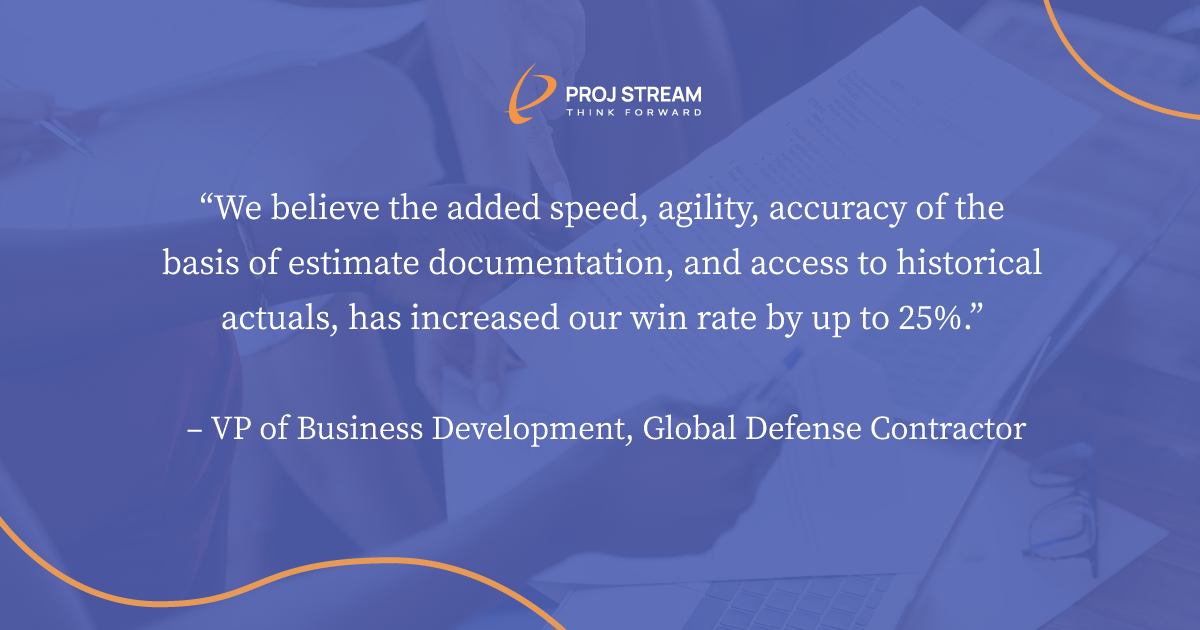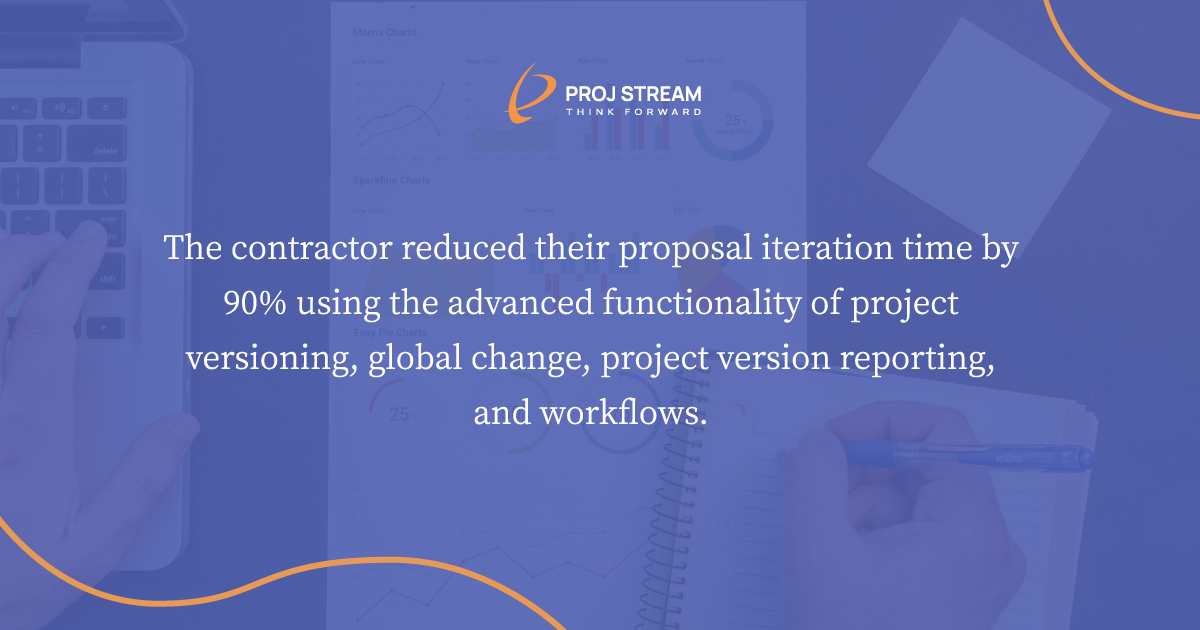A large military defense contractor with worldwide interests in aerospace, defense, information security, and technology needed to improve the speed and quality of their RFP responses.

The corporate business development executive sought out ProjStream to help them address several inefficiency issues that were causing a reduction in the quality of the firm’s proposals. In addition, the contractor wanted to be able to turn around estimate iterations quickly –a couple of days vs. the month-or-more long process they’d been living with using a homegrown solution.
To accomplish this, the contractor needed a system to act as a single source of truth where all data lived. Additionally, the client wanted to have changes made to estimates push the new data to their pricing and scheduling databases automatically, which required integration with MS Project and an existing pricing system.
Following a four-week test period, ProjStream’s solution showed it could provide the speed and agility they sought while automatically keeping pricing and scheduling data in sync. Since adopting BOEMax and MaxTeam, the firm has reduced its basis of estimate justification documentation error rate to less than 2%, down from 30%.
And the new system has reduced the proposal iteration time by 90%. “One of the biggest benefits we’ve had is the use of historical actuals as part of our data-driven estimating process. It’s a bit early to tell, but we believe the added speed, agility, accuracy of the basis of estimate documentation, and access to historical actuals, has increased our win rate by up to 25%.” –VP of Business Development.
About the Contractor
This contractor is a US-based contractor with global interests in aerospace, defense, security, and technology. Boasting a diverse portfolio ranging from military equipment to software systems and information processing, the firm manages a variety of government contracts and private partnerships.
Challenge: In Search of an End-to-End Solution
The corporate business development executive sought out ProjStream to help them address several efficiency issues in the RFP process that negatively impacted their proposals. They needed a system that could address these issues in the capture and transition phases of the proposal process and data system inefficiencies.
Capture and Transition Phase Challenges
Personnel Issues
There was often a loss of knowledge continuity and personnel retention moving from capture to execution. The execution program manager and key personnel for delivery were often absent during the capture phase resulting in a lack of continuity. The program execution teams could not leverage the basis of estimates, assumptions, and other details the proposal team developed to produce the proposal submittal increasing the duration of the startup phase for new program awards.
Technical and Programmatic Issues
A major issue that surfaced was the limited maturity of program requirements and how this problem was handled. Requirements were often taken at face value, and implicit requirements were developed from higher-level requirements without interaction with the customer. There was also a lack of definition of sell-off criteria and methodology; the exit criteria for scope items were not developed or negotiated.
A result of these planning deficiencies was the common problem of an unrealistic staffing ramp, causing the contractor not to meet the staffing plans communicated as part of the baseline delivery. Additionally, there were often incomplete negotiations on critical subcontracts. This problem often became a cost driver that would push the boundaries of the original contract value early into the execution phase.
Changes to the program baseline were not analyzed, integrated, or controlled due to the loss of personnel with knowledge of the original capture plan and the absence of systems to organize and track such changes.
Risk Management Issues
The firm couldn’t adequately execute pre-award risk reduction activities due to the lack of detailed plans during capture to align with the risks, assumptions, and challenges to the financial commitment. Risk reduction activities were not integrated into the program plan and business rhythm, compounding the existing challenges.
Data Systems Challenges
Many problems were identified with data handling as part of the proposal process. Some of the major issues included:
- Cost estimates were independent of a resource-loaded schedule.
- Iterations in proposal assumptions were significant undertakings and could take 30 to 60 days.
- The same data existed in multiple places, and no common source tied it together. Because the data systems were disconnected, scope changes, internal challenges to the estimate, or changes in rates were problematic.
- The contractor had an average error rate of 30% on the basis of estimate justification documentation.
- After the firm won the program, the execution team received proposal data with no digital thread. More often than not, it was very difficult to create a resource-loaded time-phased baseline integrated with technical scope.
Process and System Challenges
Proposal estimates were managed using a mix of toolsets and files, primarily produced with Microsoft Project, Word, Excel, and PowerPoint paired with an unconnected pricing system.
Cost estimates were completed in Excel and then passed to the pricing system. There was no connection between the cost estimate data and the schedule in MS Project because the schedule was not resource-loaded. The estimates did not automatically update pricing; this was a static feed. Basis of estimate justifications required manual updates. Because the data resided in many places and was not synchronized or automated, major iterations required 30 days or more to produce.
Another issue was the limited knowledge continuity between the business capture and the program execution teams. The lack of a digital thread for proposal data and silos between personnel created a "wall" that negatively impacted the project execution.
The illustration below represents the contractor’s system at a high level before ProjStream.
Solution: ProjStream Delivered a System that Provided Speed and Agility
As the contractor's team sought an estimating system to bring this data together, they had critical functionality in mind. The right solution had to provide a single source of truth; they wanted to enter the estimates and the rationale in the same application using a single database, so data would only be touched once. Additionally, they wanted the estimates to be the input source where the estimate updates automatically updated the MS Project schedule data along with automatic pricing updates. Lastly, a critical requirement was the speed and agility to turn around estimate iterations in a couple of days instead of 30 days or longer.
After evaluation, the contractor’s team determined that ProjStream could deliver more with a rapid ROI than the homegrown solution they were working with at the time. This determination resulted from running a four-week test pilot, a proof of concept on key speed and agility needs, and testing the one source of data/data synchronization concept with scheduling and pricing.
The ProjStream implementation team was able to deliver a solid solution that met the contractor's requirements. Users could synchronize their cost estimates with a resource-loaded schedule in MS Project and synchronize the cost estimates with the pricing system of record with mechanisms ProjStream put in place. (ProjStream's BOEMax can produce all required reporting for pricing; however, this contractor chose to maintain their existing pricing system of record.)
The contractor reduced their proposal iteration time by 90% using the advanced functionality of project versioning, global change, project version reporting, and workflows. Proposal change requests that once took 30 days to implement now take only three.
“The ProjStream system provides the speed and agility we were looking for,” said the firm’s Vice-President of Business Development. “We now consider this portion of the RFP response phase a competitive advantage because we can save our starting point, make logical batch changes based on scope or rate changes and then compare the deltas using project version reporting. Things that used to take us days now take hours to complete.
“We were able to reduce our basis of estimate justification documentation error rate to less than 2%, down from 30%, due largely to the ability of BOEMax to tie the basis of estimate reporting to the source documentation. We have also been able to stop the toss over the wall syndrome and have been able to pass on resource-loaded and time-phased cost estimate plans over to the project execution team to be loaded into the earned value cost system.”
In this case, the contractor converted to ProjStream’s MaxTeam because of the integration advantages and the possibility of a closed-loop system feeding back historical actuals as a reference point for new proposal estimates.
Key Benefits of an End-to-End Experience
The biggest benefits of adopting an integrated BOE, scheduling, and pricing tool identified by this customer have been:
- Reduction of error in basis of estimate justification documentation from 30% to less than 2%.
- Proposal iteration time reduced by 90% (from 30+ days to three)
- An increased win rate by 25%
- Improved understanding of project risks.
- A single source of truth for data, synchronized with other systems.
- Increased execution team buy-in, cross-over, and participation from the program manager and key personnel during the capture phase.
Recognizing Efficiencies with ProjStream
“The benefits of an integrated BOE, scheduling and pricing tool has been a much more efficient use of our B&P (bid and proposal) funds and resources. Also, because of the ability to resource load our schedules from the cost estimating tool, we have a much more mature project baseline plan prior to startup,” explained the VP.
“We have been able to gain a much better understanding of program risks and now have a much more efficient transition to the program execution phase. Additional benefits have been created from more visibility into the data early on, which has introduced more buy-in, cross-over, and participation from the program manager and key personnel during the capture phase. This has literally started breaking down the silos. Because the scope of work being delineated into requirements has become more visible as part of the process, the maturity of program requirements has improved much earlier on in the process.”
“One of the biggest benefits we’ve had is the use of historical actuals as part of our data-driven estimating process. It’s a bit early to tell, but we believe the added speed, agility, accuracy of the basis of estimate documentation, and access to historical actuals has increased our win rate by up to 25%.”




